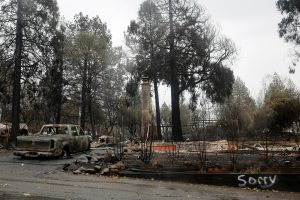
(Reuters) – The deadliest wildfire in California history that destroyed the mountain town of Paradise and killed at least 85 people was 100 percent contained on Sunday, according to state fire officials.

FILE PHOTO: The word “sorry” is spray painted on the edge of a property burned by the Camp Fire in Paradise, California, U.S. November 21, 2018. REUTERS/Elijah Nouvelage
The number of people still missing from the Camp Fire north of San Francisco dropped to 249 on Sunday, the Butte County Sheriff’s Office said. The number was revised down from 475 as people who were believed missing were found in shelters, staying in hotels or with friends, officials said, adding that many did not know they were on the list.
The Camp Fire that started on Nov. 8 destroyed nearly 14,000 homes and burned nearly 154,000 acres (62,000 hectares) – an area five times the size of San Francisco.
Searchers will have a few more days of dry weather, but starting late Tuesday, another 2-5 inches (5 to 13 cm) of rain is expected to drop on the Sierra Nevada foothills through next Sunday, hampering the searchers work and renewing fears of flash floods and mudslides, forecasters said.
“The fear is that the rain will drop in intense bursts,” Brian Hurley, a meteorologist with the federal Weather Prediction Center in College Park, Maryland, said early Sunday.
“All the vegetation has burned away, and that’s a dangerous recipe for mudslides,” Hurley said.
Last week, 2-3 inches (5-8 cm) of rain fell there and turned ash from the thousands of destroyed homes into slurry, complicating the work of finding bodies reduced to bone fragments.
Butte County Sheriff Kory Honea has warned that remains of some victims may never be found.
The town of Paradise was a popular destination for retirees, with people aged 65 or older accounting for a quarter of its 27,000 residents. Most of the victims of the fire identified so far were of retirement age.
Investigators have yet to determine the cause of the fire.
Thousands of people forced to flee Paradise spent Thanksgiving in warehouses in the nearby city of Chico, or with friends or relatives in nearby towns.
(Reporting by Rich McKay in Atlanta; additional reporting by Andrew Hay in New Mexico, Alex Dobuzinskis in Los Angeles and Gabriella Borter and Gina Cherelus in New York; Editing by Lisa Shumaker)







